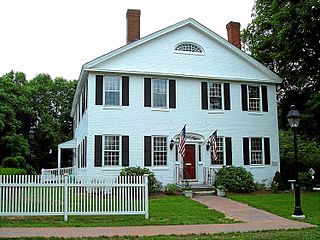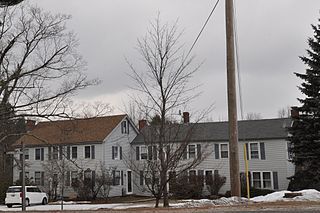
The Luther Brooks House is a historic house located at 34 Kirkland Street in Cambridge, Massachusetts.
The William Luther House is a historic house in Swansea, Massachusetts. It is a 1+1⁄2-story wood-frame Cape style house, five bays wide, with a side-gable roof, central chimney, clapboard siding on the front and wooden shingles on the sides. The front door is an original vertical board door. An ell extends to the rear of the house, added in the late 19th or early 20th century. The house was built c. 1849, and is a well-preserved example of Greek Revival styling. The house was for many years owned by members of the locally prominent Buffington family.

The Luther House is a historic house in Swansea, Massachusetts. It is a 1+1⁄2-story gambrel-roofed wood-frame house, five bays wide, with a central chimney and wooden shingle siding. Its main facade is symmetrically arranged, with a center entrance that has a transom window above. An ell extends to the right side, and dormers in the roof are a later addition. The house was built c. 1740, probably by Hezekiah Luther, son of John Luther, the first of that name to settle the area. It was long associated with the Luthers, a locally prominent family, whose members owned this house until the mid-20th century.

The Bennett-Shattuck House is a historic house at 653 Martins Pond Road in Groton, Massachusetts. Built c. 1812, it is a well-preserved example of rural Federal period architecture, and is associated with a property that was farmed for two centuries. The house was listed on the National Register of Historic Places in 2006. Most of its associated farm property is now local conservation land.

The Hapgood House is a historic house in Stow, Massachusetts. Built c. 1726, it is a well-preserved late First Period, including a rare surviving stairway balustrade from the period. The house was listed on the National Register of Historic Places in 1990.

The Jonathan Fletcher House is a historic house in Medford, Massachusetts. The 2+1⁄2-story wood-frame house was built c. 1835; its builder clearly drew inspiration from designs published by Asher Benjamin, and is an excellent example of transitional Federal-Greek Revival architecture. The house was listed on the National Register of Historic Places in 1975.

The Addington Gardner House is a historic First Period house in Sherborn, Massachusetts. Its oldest portions dating to about 1730, it is one of the community's oldest surviving buildings, and a good example of transitional First-Second Period style. The house was listed on the National Register of Historic Places in 1990.

The Hagar–Smith–Livermore–Sanderson House is a historic house at 51 Sanders Lane in Waltham, Massachusetts. The 2+1⁄2-story wood-frame house was built in several stages, and is considered to be the city's oldest surviving structure. Its oldest portion, now an ell attached to the main block, may have been built as early as 1716, although architectural evidence suggests a date in the mid-18th century. This structure is attached to a larger main block that is now 2+1⁄2 stories with a slate gambrel roof. This section, however, also began as a 1+1⁄2-story structure, built in the 1780s. The house reached its current proportions in the mid-19th century, which is when it received its Italianate styling. The house has long been associated with a number of families prominent in the affairs of the town.

The Captain Goodwin–James Eustis House is a historic house in Wakefield, Massachusetts. Built about 1760 and enlarged around 1830, it is a good local example of Greek Revival architecture, which was owned by a prominent local businessman and civic leader. The house was listed on the National Register of Historic Places on March 2, 1990, where it is listed as the "Captain Goodwin–James Custis House".

The House at 8 Park Street, also known as the Dr. Joseph Poland House, is a historic house at 8 Park Street in Wakefield, Massachusetts. The 2+1⁄2-story wood-frame house was built c. 1852 for Dr. Joseph Poland, who only briefly practiced in the town. The house is in a vernacular Italianate style, with a two-story ell on the rear and a porch on the right side. The house has elongated windows with entablatured surrounds. The porch and front portico are supported by turned columns with bracketed tops, the building corners are pilastered, and there are paired brackets found in the eaves and gable ends.

The Suell Winn House is a historic house at 72-74 Elm Street in Wakefield, Massachusetts. The house was built c. 1805 for Major Suell Winn, a local farmer, and is one of the best representatives of Federal-style architecture in Wakefield. It is a 2+1⁄2-story wood-frame structure, with two interior chimneys, a five-bay facade, and an elegant doorway with sidelight windows and an architrave. An ell extends the house to the right. Winn, a native of nearby Burlington, was killed crossing the railroad that divided his landholdings, after attending a town meeting where he protested the need for improved crossing signals at that location.

The Augustus Post House, also known as Hewitt House, is a historic house in Hebron, Connecticut. Built about 1820, it is a prominent local example of Federal period architecture, whose occupants have included prominent local businessmen and one Governor of Connecticut. It was listed on the National Register of Historic Places in 1982.

The Wilder Homestead is located on Ashfield Road, 0.25 miles (0.40 km) south of the Upper Road/Ashfield Road junction, in Buckland, Massachusetts. The property includes three buildings, two of which contribute to its significance. The house was built c. 1775, and is a fairly typical Georgian colonial two story house, in which the rear roof extends down to the first floor in saltbox fashion. A 19th century ell extends from the east side of the house. The house was built for Gardner Wilder, who had recently moved to the area, and had purchased 200 acres (81 ha) to farm.

The Daniel Carr House is a historic house on Brier Hill Road in Haverhill, New Hampshire. Built about 1796, the house is most notable for the high quality folk murals drawn on its walls, most likely by the itinerant artist Rufus Porter between 1825 and 1830. The house was listed on the National Register of Historic Places in 1992.

The Stephen Rowe Bradley House is a historic house at 43 Westminster Street in Walpole, New Hampshire. The large Federal style mansion house was built c. 1808 for Francis Gardner, a lawyer and state legislator. From 1817 to 1830 it was the home of Stephen Rowe Bradley, a Vermont lawyer, judge, and politician, who played a significant role in Vermont's entry into the United States as the fourteenth state, representing the independent Vermont Republic in negotiations over its boundaries. This house is the only known surviving location associated with Bradley's life. The house was listed on the National Register of Historic Places in 2005.

The Edward H. Lane House is an historic house located at 16 Cottage Street in Littleton, New Hampshire, United States. With a construction history dating to about 1830, it is a good architectural catalog of changing trends in local styles and economic circumstances. Its front portion, dating to the late 19th century, is a good example of Queen Anne Victorian architecture. The house was listed on the National Register of Historic Places in 1980.

The Isaac Greenwood House is a historic house on New Hampshire Route 101 in eastern Dublin, New Hampshire, United States. The oldest portion of this house was built c. 1784 by Isaac Greenwood, a veteran of the American Revolutionary War. The house, a good example of additive architecture of the 19th century, was listed on the National Register of Historic Places in 1983.

The Woodman Road Historic District of South Hampton, New Hampshire, is a small rural residential historic district consisting of two houses on either side of Woodman Road, a short way north of the state line between New Hampshire and Massachusetts. The Cornwell House, on the west side of the road, is a Greek Revival wood-frame house built c. 1850. Nearly opposite stands the c. 1830 Verge or Woodman House, which is known to have been used as a meeting place for a congregation of Free Will Baptists between 1830 and 1849.

The Rev. George Daman House is a historic house on Wyman Lane in Woodstock, Vermont, USA. Built in 1782 on the town's original 150-acre (61 ha) ministerial lot, it is a fine example of transitional Georgian/Federal styling in southeastern Vermont. It was listed on the National Register of Historic Places in 1989.

The Sargent-Robinson House is a historic house in Gloucester, Massachusetts. Built about 1760, it is a well-preserved example of an iconic local form, the gambrel-roofed cottage. It also includes probable foundational remnants of the c. 1700 house built on the site, and was owned into the 20th century by descendants of Samuel Sargent, who settled the land in 1695. It was listed on the National Register of Historic Places in 2016.






















